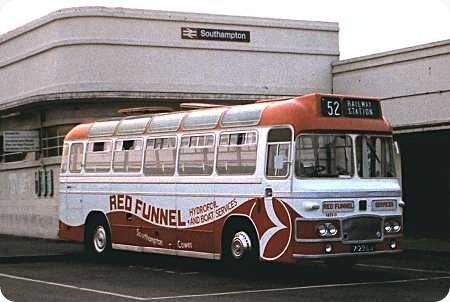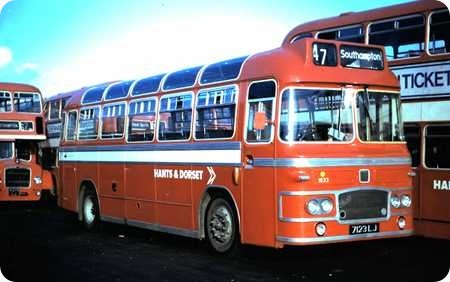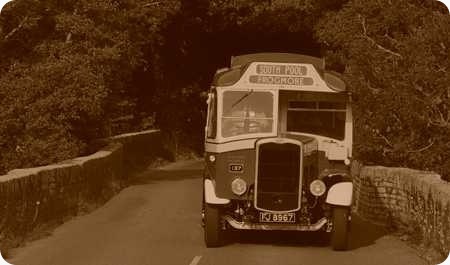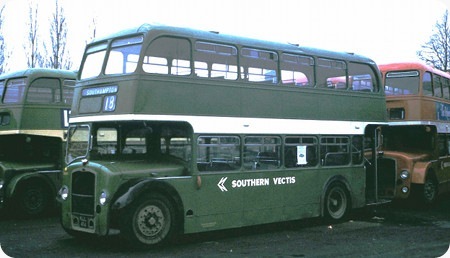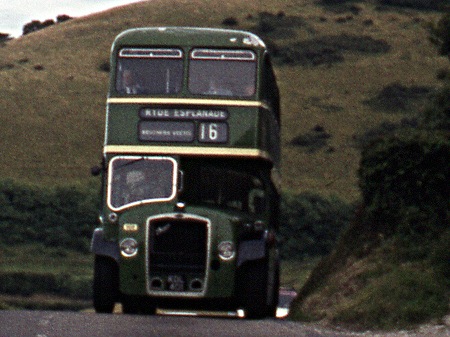Hants & Dorset – Bristol MW6G – 7123 LJ – 1833
Hants & Dorset Motor Services
1962
Bristol MW6G
ECW C39F
This Bristol MW with, as it was called then, the ‘New Look’ design was new to Hants & Dorset as their fleet number 887 in June 1962. In 1963 the batch (882 – 887) were down seated to C30F for extended tours, but reverted to C39F in 1968. In the first view, she has been downgraded to local bus work, as DP41F and is in special livery for the RED FUNNEL FERRIES contract and is seen at Southampton Central Station in April 1974. Her sister, 7122 LJ, was in BRITISH RAIL SEASPEED livery at the same time, but my view of the sister is not suitable for publication.
In the second view of 7123 LJ, the relegation to service bus duty is complete, having been repainted in NBC poppy red livery with white stripe in 1975. She’s in the yard of Southampton depot in January 1976. In both views, she has the fleet number 1833 but for a brief time in 1971 she had the fleet number 1001.
Photograph and Copy contributed by Pete Davies
———
14/12/12 – 07:21
Never thought NBC poppy red could be an improvement on another livery but…..
Eric Bawden
———
14/12/12 – 07:22
When I photographed sister vehicle 1831 in 1973 on local service at Winchester, she was still fitted with high back seats. I’m amused by the fact that in the upper view, 1833 retains wheel trims, but has been relegated to bus seating.
Alan Murray-Rust
———
14/12/12 – 08:50
Indeed, Eric! I have vague memories that Southern Vectis had a vehicle in similar livery, for the Cowes to Newport element of this service, though I never photographed it. The service connected with the express trains from Waterloo and, in later years, had the service number 91, to match the train headcode! Different people have operated the link over the years, including Marchwood Motorways (using a Ford with Duple coach body and special livery) and Southampton Citybus (both before and after they sold out to First) Current operation is called "City Link" and the Unilink version of Solent Blue Line runs it.
Pete Davies
———
14/12/12 – 10:44
I like to think that even me, colour-blind, would not have come up with such a hideous range of colours and patterns as the poor suffering bus has in the top photo. Sun glasses might have helped! I always liked the ‘New Look’.
Chris Hebbron
———
14/12/12 – 16:26
Just a different way of applying poppy and white, Mr H!!!
Pete Davies
———
15/12/12 – 12:00
Mansfield District had some of these type vehicles, good looking coaches when new, however, the downgrade to DP services saw the addition of the linen box grafted onto the front dome, it spoilt ’em though at least Mansfield fully removed the original two boxes above the headlights.
Berisford Jones
———
15/12/12 – 14:32
Berisford, I’m not sure what happened to this batch with Hants & Dorset, but most of the H&D coaches just had the box, illuminated, with the lettering HANTS & DORSET under the driver and HOLIDAY TOURS in the other one. Some of the RE coaches, down to NBC DP livery, had the HOLI removed.
Yes, removal of the box would probably have made the outline better!
Pete Davies
———
15/12/12 – 16:21
I like the design of these vehicles – I don’t like the destination box. For comparison take a look at a similar Royal Blue coach at this link which doesn’t have such a box
Ken Jones
———
16/12/12 – 11:00
Yes, Ken, same here! So far as I know, Royal Blue coaches weren’t downgraded to DP or bus work, so they never needed that box in the dome.
Pete Davies
———
16/12/12 – 12:14
United had some of these with a different front panel and destination layout. Drab olive green and cream sounds hideous for a coach livery, but anyone who has ever seen one of United’s coaches will tell you, it works, and these were no exception.
Ronnie Hoye
———
16/12/12 – 14:44
Although some of the Royal Blue MW vehicles like EDV 502D had Western National branding instead of Royal Blue they never [thank goodness] received these horrible destination boxes. There’s a picture at this link showing ENOC with an equally horrible destination box
Ken Jones
———
16/12/12 – 17:31
The later vehicles with the deeper windscreens, such as the one in the link Ken posted never looked right to my eyes and I agree Ken, that thin profile linen display box looks very wrong. Not one of ECW’s best at all.
Berisford Jones
———
17/12/12 – 08:09
You are spot-on with your comments about the United olive green and cream livery Ronnie. It doesn’t sound great on paper, but ‘in the metal’ it had a touch of class. United’s Plaxton-bodied Bristol REMHs brought in a simpler more up to date style later on, yet they still looked stunning. They even retained the scroll-type fleet names.
Brendan Smith
———
17/12/12 – 13:04
Brendan, going off the subject slightly, I know a couple of United L’s have survived into preservation ‘I believe one is in Durham District livery’ but do you know of any DP versions in the reverse livery?
Ronnie Hoye
———
17/12/12 – 16:39
The full list of Bristol L survivors can be found at www.bristolsu.co.uk/ but I don’t think there is an United vehicle in reverse livery. Crosville KFM 893 is in reversed livery. HHN 202 is preserved in Durham District livery as seen at www.sct61.org.uk/
Ken Jones
———
19/12/12 – 07:25
I noted above that I had vague memories of a Southern Vectis vehicle in the same special livery. I’ve found it, in a bought slide from Omnicolour. If you think this is bad, just consider a Bristol FS (VDL 844 to be precise!) then go and lie down in a darkened room until you recover.
Pete Davies
———
19/12/12 – 13:42
On the same link Ken Jones mentions above, you will find a picture of one of these ‘7014 HN’ plus one or two other examples of United coaches, in particular is a 1964 Leyland Loepard L2 with Plaxton Panorama body, it became part of United’s fleet when they acquired Wilkinson of Spennymoor in 1968, but they all prove the point that quiet restraint is often more dignified than ‘flash and brash’
Ronnie Hoye
———
20/12/12 – 07:54
Ronnie, sorry but I don’t know if there is a United Bristol L preserved in DP livery. The only ones I’m familiar with are in bus livery – HHN 202 (Durham District green) and two red LS – rear entrance LHN 823 and front entrance LHN 860. The latter vehicle made a touching appearance at Charlie Bullock’s funeral in Scarborough in August, complementing Charlie’s United K5G towing wagon FHN 923, which provided his ‘personal transport’ for the proceedings.
Brendan Smith
———
20/12/12 – 09:45
Ronnie, I’ve just been reading through comments related to United Auto Bristol LL6B NHN 128 on this splendid website, which should interest you. Present owner David Hudson comments that this vehicle is awaiting restoration following fire damage. He also states that the vehicle was converted to DP configuration in 1953, so maybe you could yet see a United L-type in reversed livery.
Brendan Smith
———
20/12/12 – 16:04
Thanks for that, Brendan, if NHN 128 were to be restored as a DP that ‘length and engine size apart’ would that make a full full set of L’s as far as United are concerned? A front and rear entrance in red, a reverse livery DP and a Green Durham District, or did D/D have DP’s as well?
Ronnie Hoye
Quick links to the - Comments Page - Contact Page - Home Page
